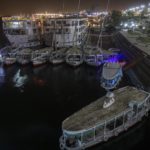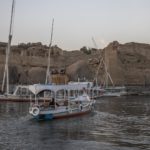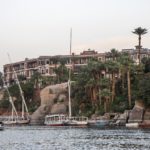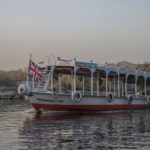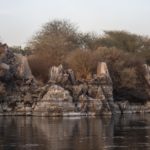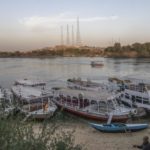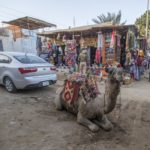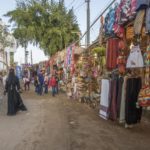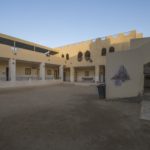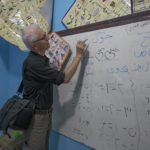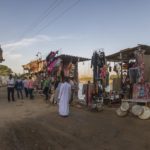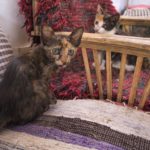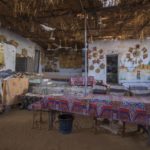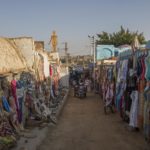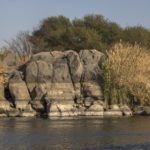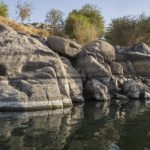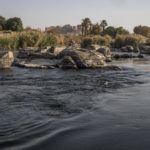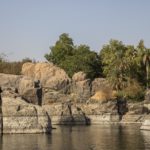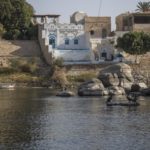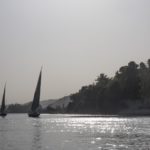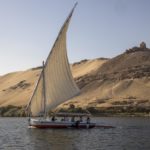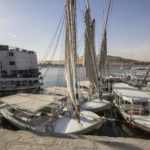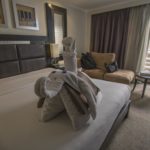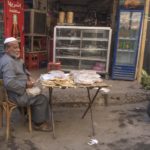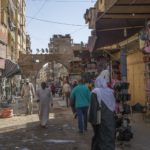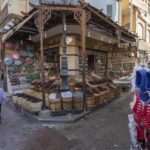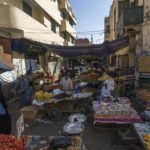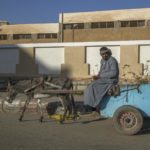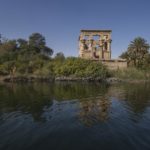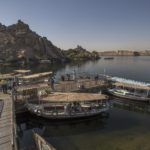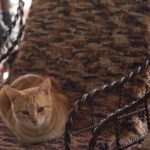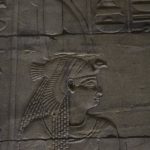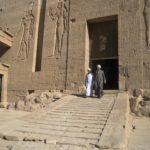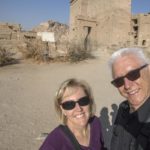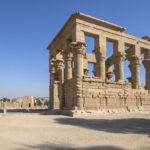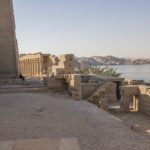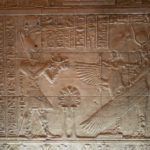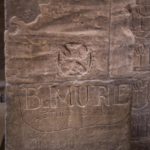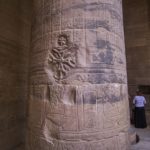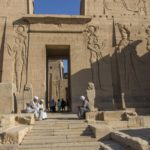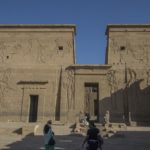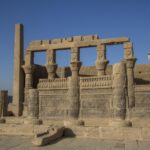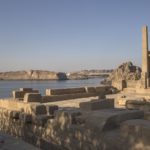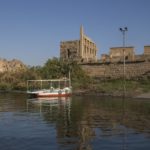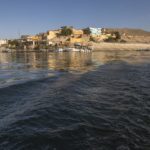A new day in Egypt and more lovely people to meet. We met our driver, Ramy, this morning, who will be taking care of us tomorrow in our transfer to the airport, as well as looking after our luggage while we are in Abu Simbel. It seems that the delightful people who work in hospitality and transport in this country have been handpicked for us! Ramy is a nice young man, whose father used to also work for Mara House where we stayed in Luxor. These connections give the visitors a feeling of surety, safety and friendship by association.
We drove through Aswan this morning at about 8am. It’s a cleaner city than Luxor, which in turn is cleaner than Cairo, which makes absolute sense. Aswan, the city, has nearly 300,000 people living in it, but it’s a little more laid back in the hard sell than Luxor. Although this may very well have been because we had our personal guide, Mohamed, with us. Maybe his presence kept the touts at bay.
Philae Temple
We took a boat ride to Philae Island where the Temple of Isis is situated, and it is one of the last temples where the goddess was worshipped (hence one of its names – ‘the last temple of Isis’). Osiris and Horus were also worshipped at this temple, and it was in use for 800 years. The remarkable thing about this place is that it used to be on Philae Island, but that island flooded regularly after the building of the first dam, so they moved the entire complex, stone by stone, to the mainland, sorted and catalogued it, and rebuilt the entire thing on Agilkia Island, which was renamed Philae Island. It took eight years to complete this process. Extraordinary the lengths a proud people will go to preserve their history and culture. And equally extraordinary, but infinitely more devastating, is what some extremists will do to destroy their country’s culture and history in the name of religion.
New Philae Island is south of the old dam, which was built in 1902, which is why we had to drive to get to the spot where we could board a boat to sail to it. The concrete jetty was flanked on either side by countless boats ready to take the anticipated visitors to the island. All a bit daunting, really. But the selection of boat was very easy, no haggling, or pushing. There was a man in charge who determined who was next in the boat taxi line. Simple. It was freeing to have Mohamed in charge of paying everyone their baksheesh over these couple of days; much easier than us trying to wrangle it all. We gave him E£100 ($7 AUD) the previous day, at his suggestion, to sort it, so we were happy tourists. Read more about the temple here.
Aswan and the River
After sailing back to our car at the port, we returned to the centre of Aswan. Our wander through the local bazaar was delightfully atmospheric yet pleasantly uneventful, with only a few people calling out for us to buy something. With Mohamed strutting his stuff before us like our security detail, we didn’t get hassled.
After lunch on board MS Concerto, we headed out again on an afternoon river cruise from Aswan to the local Nubian village. These people are believed to be the earliest inhabitants of the central Nile Valley, and one of the earliest cradles of civilisation with an ancient history that predates dynastic Egypt.
At 3pm, the low sun was shining through the fluffy flowers of the reeds by the water’s edge, creating a golden fairy floss halo before the breeze blew their miniscule fairy dust across the water. Drifting past an island on our journey, Mohamed pointed out a lush garden that was started by Lord Kitchener. He loved plants, and the island was granted to him after his role in the Sudan conflict. It was a stark contrast to the looming sand dune signalling the desert behind it.
As the river journey continued, Agah Khan’s tomb rose high on a sandy ridge above the house he used to live in when he came to Aswan for winter to ease the rheumatism in his legs. He achieved this relief by burying his legs in the hot sand – unusual treatment, but obviously effective. His wife, 30 years his junior and who died in 2002, was buried with him. She paid for someone to put a flower on his grave every day, even after her death. Love…and money!
The final natural highlight of the afternoon came in the form of jumping perch! Several of these slippery, silver creatures were hopping over the gently, swirling current of the Nile.
Nubian Village
The Nubian village was the most colourful place we have seen in all of Egypt. The Nubian people adore colour, and it shows! We walked along the street that ran parallel to the river, declining the offer to alight from the boat early and take a camel ride to the village. We had tea in a woman’s house that was filled with cats and kittens, as well as colour! She also had four crocodiles as pets!!! There were two large ones in a tile pit (the only way I could describe it) that was not long enough for them to be fully outstretched, so they had to lie on top of one another. There were two small crocodiles in a glass fish tank, but again, they had grown too big for the tank, and one had its nose bent upwards against the glass. The Nubians keep the crocodiles for good luck, but I found it terribly sad. But we thanked her for her hospitality and her tea, and continued on our way.
Our host for tea was a widow whose husband had died about 14 years ago, and she had no intention of remarrying. Not at all unusual for cultures with arranged marriages – if there is an income, why remarry and lose the freedom and social standing that comes with being a widow?
We strolled and browsed along the shopping street, but didn’t tarry – we didn’t feel like we could stop and look without getting the hopes up of the vendors, so we kept a middle line and kept walking. We did stop at the local kindergarten and had a brief lesson in numbers and alphabet of both Arabic and Nubian. We sucked at both, really, but were eager and attentive students!
The sun had gone below the horizon when we journeyed back to the MS Concerto. The mesmeric call to prayer could be heard over the motor of the small boat, and we breathed in the last moments of this specific place on the planet before being destined to move on the next morning. One final spot to be pointed out on the shoreline was the Old Cataract Hotel. A fitting point of focus seeing as one of its many famous guests was Agatha Christie when she wrote Death on the Nile.
Our adventures in Egypt continue…
Read our full Nile River story here:
Part 1: Edfu & Kom Ombo Temples
Part 2 (current): Philae Temple & Nubian Village
Click on any image below to view as gallery
- Cruise boats docked at Aswan, Egypt
- A new meaning for ‘armchair travel’, or in this case, ‘armchair cruising’, Nile River, Aswan
- Old Cataract Hotel, where Agatha Christie wrote ‘Death on the Nile’, Aswan
- Small cruising boat, Nile River, Aswan
- Water levels marked on the rocks, Nile River, Aswan
- Boats and power lines near the Nubian village, Aswan
- Two modes of transport on offer in the Nubian village, Aswan
- Shops in the Nubian village, Aswan
- Nubian village school, Aswan
- John having a go at writing in Arabic, Nubian village, Aswan
- Main street of Nubian village, Aswan
- Cats in the Nubian Village house where we had tea
- Living area of the house where we had tea, Nubian Village, Aswan
- Clothing for sale in the Nubian Village, Aswan, Egypt
- Rocks and reeds on the bank of the Nile, Aswan, Egypt
- Beautifully marked rocks on the Nile, Aswan, Egypt
- Swirling water of the Nile River, Aswan, Egypt
- Rocky shore of the Nile, Aswan, Egypt
- Houses on the shore of the Nile River, Aswan, Egypt
- Afternoon feluccas, Aswan, Egypt
- Felucca at Aswan, Egypt
- Boats at the dock at Aswan, Egypt
- Towel arrangement extravaganza on MS Concerto, Egypt
- Breadman, Aswan, Egypt
- Aswan street, Egypt
- Corner store, Aswan, Egypt
- Aswan market, afternoon, Egypt
- Man and his donkey, Aswan
- Goodbye, Philae Temple, Egypt
- Leaving Philae Island, Egypt
- Cafe cat, Philae Island, Egypt
- Carving of Isis, Philae Island, Egypt
- Exiting Philae Temple, Egypt
- Nic and John on Philae Island, Egypt
- Temple on Philae Island, Egypt
- View of the shore of the Nile from Philae Island, Egypt
- Carvings at Philae Temple, Egypt
- Translation of the Latin: “B.Mure…is an idiot!” Philae Temple, Egypt
- Coptic graffiti in Philae Temple, Egypt
- Men waiting at the entrance to Philae Temple, Egypt
- Entrance to Philae Temple, Egypt
- Philae Temple, Egypt
- The view of the mainland from Philae Island, Egypt
- The approach to Philae Island, Egypt
- Aswan from the boat taking us to Philae Island, Egypt

